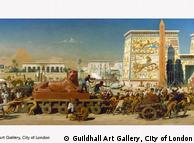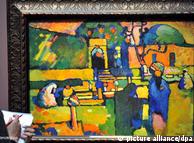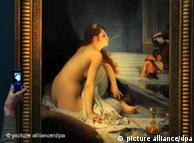Art | 01.02.2011
Munich exhibition uncovers Europe's historical fascination with the Orient
The Orient fascinated Europe for hundreds of years; as early as the 15th century, Renaissance artists included figures in turbans and flowing Eastern robes in their works.
It was, however, an attempt by Napoleon Bonaparte to conquer Ottoman-ruled Egypt that triggered a craze for all things Oriental that would enthral Europe for the entire 19th century.
In 1798, Napoleon marched into Egypt, only to be kicked out by the British three years later. His short-lived imperial adventure was, "in a military sense, a big failure, but in a cultural sense, it was a hugely influential historical event," said Roger Diederen, the curator of the "Orientalism in Europe" exhibition currently running at the Kunsthalle of the Hypo Cultural Foundation in Munich.
This is because Napoleon's army of 40,000 men was accompanied by 167 artists and scholars.
"They started studying Egypt - but not just historical Egypt, but also contemporary Egypt; the birds, reptiles, the landscape," explained Diederen. "These findings were published in a very important work called 'Les Descriptions de' l'Egypte' of 22 volumes with lusciously illustrated folios."
Opening up of the East
Following in Napoleon's footsteps, a trickle and then a torrent of Westerners began exploring the region then ruled by the Ottoman Empire, which encompassed countries in much of Northern Africa, the Near East and the Middle East, with Istanbul as its capital.
"Generally, it became slightly less complicated to travel and rail roads started to be built," said curator Diederen. "Trade was intensified. And, of course, colonialism was an extremely important factor."
Famous artists such as Eugene Delacroix, Jean-Léon Gérôme, Eugene Fromentin, Auguste Renoir, Ludwig Deutsch and John Frederick Lewis were among those who packed their paint brushes and sketch books, and made their way to the East.
Some were part of diplomatic missions, others wanted to experience the landscapes described in the Bible; and then there were those who simply craved adventure.
 Bildunterschrift: "Israel in Egypt" (1867) by Edward Poynter
Bildunterschrift: "Israel in Egypt" (1867) by Edward Poynter
Tourist motifs
The sketches and paintings they sent back often depicted a typical touristic selection of motifs - desert landscapes, Bedouin camel trains, street scenes showing barbers, shoe makers and sword traders at work, ancient temples and mosques.
Other artists didn't even bother to leave home. Using Oriental furnishings, props and costumes, they painted their pictures in their London or Paris studios.
At the "Orientalism in Europe" exhibition in Munich, curator Diederen pointed to an oil painting by Jean-Joseph Benjamin Constant showing a naked female slave reclining in a room furnished in Oriental style.
"I found a photograph of the artist's studio in Paris and you can see exactly the same oriental carpet and you see a similar niche," Diederen said. "It is very clear that this picture was constructed in his studio and if you look closely she has red hair and she was used in other pictures, not just Oriental ones."
The slave was merely a construction, added Diederen, "a fantasy that appealed to the audience." And there was a booming market for that kind of art at the time.
Detailed realism
The style of most of the art is hyper-realistic with almost photographic details painted in saturated colors. Despite the often breathtaking beauty of the paintings, though, the genre fell into disrepute in the 20th century. The style - known as academic art - was disparaged as being too sentimental and too old-fashioned.
This was in part because, by the end of the 19th century, the genre was so wildly popular that the market was swamped with third-rate paintings with clichéd subject matter.
The director of Munich's Kunsthalle, Christiane Lange, says now is the time to sift through Orientalism and discover the works worth remembering.
"In all centuries, in all places in the world, you always have painters who are geniuses, some who are good quality, and an armada of really weak ones," Lange said. "The weak ones should never be those which make you decide how good an entire class of painting is."
 Bildunterschrift: "Arabic Cemetery" (1909) by Vassily Kandinsky
Bildunterschrift: "Arabic Cemetery" (1909) by Vassily Kandinsky
Politically incorrect?
Another criticism levelled at Orientalist art is that it is politically incorrect. Many of the paintings are propaganda tools supporting Western imperialism - depicting the East as a place of backwardness and barbarism.
Although this claim does apply to many works, it cannot be generally leveled at all Orientalist art.
For example, a contemplative portrait of a Muslim man praying, created by German painter Ludwig Deutsch, shows the artist's obvious respect for the subject matter.
For journalist and Middle East expert Peter Scholl-Latour, who was in Munich to speak at the opening of the exhibition, many of the works hanging in the Kunsthalle convey the painters' "feelings of astonishment and fascination."
Whether some of the paintings may be too cloyingly sentimental or clichéd for some people's liking, the "Orientalism in Europe" exhibition offers a stunning and comprehensive look at how the West viewed the East more than a century ago. More than 150 objects, mainly oil paintings, from more than 100 artists are included in the show.
"Orientalism in Europe" runs until May 1 at the Kunsthalle of the Hypo Cultural Foundation. It then travels to the Centre de la Vieille Charité in Marseilles from May 27 to August 28, 2011.
Author: Kate Hairsine, Munich
Editor: Kate Bowen

沒有留言:
張貼留言